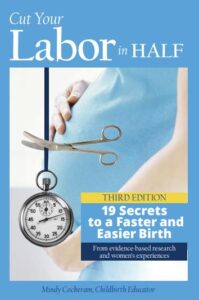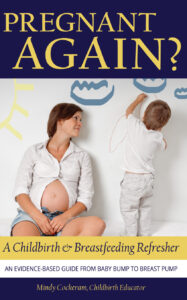.
Private Childbirth & Breastfeeding Education
Providing private in-person and virtual Childbirth & Breastfeeding Classes for a positive birth experience. Click Private Class Enquiry for more information.
I have always compared labor to mountain climbing. Early labor is when you fuel up, keep warm and plan your route in your base camp tent. Active labor needs stamina to traverse icy slopes and overcome unknown weather patterns. Transition is when you teeter over the crevasse on a ladder. Finally you push, push, push for the summit and once you reach it, what you see renders you relieved, joyous and possibly speechless.

Photo by Chad Tetzlaff on Unsplash
Just like when climbing a mountain, food and fluid are the fuels that keep your muscles working and allow you to keep going in labor. Since hospitals generally discourage eating in labor (or outright won’t allow it), we usually have a classroom discussion on useful things to eat at home, in the car and in the parking lot!
A few years ago I listened to a really useful InJoy webinar given by CRNA Amy Wehrman on Oral Intake During Labor (recorded on www.injoyhealtheducation.com – March 23, 2016). In the webinar, she recommends eating from the BRAT (bananas, rice, applesauce, toast) diet since these foods are gentle on the stomach and less likely to cause vomiting. Of course she also points out the lack of evidence based research for denying women food in the hospital but many have highlighted this – as well as the need for change. Besides the BRAT diet foods, I have come upon a few studies that highlight some food for thought (excuse the pun) in labor.
BAKING SODA (SODIUM BICARBONATE)
Athletes employ many different food theories and diets to enhance or improve their performance. One of those methods, referred to as a ‘buffer’, is the use of baking soda (aka sodium bicarbonate). Dissolved in water (0.3g sodium bicarb/kg body weight) and taken roughly an hour before the event allows resistance against muscle exhaustion caused by changes in acid-base balance. Sodium bicarbonate has a proven neutralizing effect on the lactic acid that forms during muscle exertion and improves performance.
In a fascinating study in 2016 out of Sweden and the UK, Wiberg-Itzel et al worked together to study the effect of sodium bicarbonate on laboring women whose contractions had become weaker and consequently less effective (dystocic). Two randomized groups of 200 primiparous women in active labor were studied. The first group received no sodium bicarbonate and oxytocin/Pitocin was started immediately (adhering to local clinical guidelines). The second group was each given 4.26g of sodium bicarbonate (using an over the counter aid for indigestion called Samarin which is readily available in Sweden) mixed with 200ml of water an hour before starting oxytocin if no progress in labor was identified.
The results were quite astonishing. 84% of the sodium bicarbonate group went on to have spontaneous deliveries versus 67% of the non-bicarb group. 6.7% of the sodium bicarb group was assisted by vacuum whereas 24.2% of the other group needed vacuum assistance. Newborns from the sodium bicarb group of mothers had overall better outcomes including no APGARS <7. It is quite clear that the sodium bicarb helped the uterus recover from the muscular changes associated with labor exhaustion.
The question remains whether women should consider using sodium bicarb without further studies and if so, how much. The only known downsides of sodium bicarbonate is that it can contribute to stomach upset and water retention and so some may not tolerate it well. Will women be using a sodium bicarbonate product in early labor routinely in future? Do you have any experience using it?
YOGURT
Over the last few years the aforementioned BRAT diet has evolved into the BRATY diet with the Y standing for yogurt. One of the reasons I encourage women to eat yogurt during pregnancy is to help avoid Group B Strep colonization. Research by Reid and Burton (2002) concluded that foods that increase lactobacilli in the pregnant woman’s diet (i.e. yogurt that contains probiotics like lactobacillus or acidophilus) can happily decrease the chance of GBS infection. In addition, some of the commonly prescribed practices in pregnancy (laxatives for constipation resulting from iron pills and calcium carbonate antacids to reduce heartburn) and the general stress pregnant women experience put them at far higher risk of killing off their ‘good bacteria’.

In labor, any antibiotics received by the mother can kill off her good bacteria. The death of good bacteria also decreases the mother’s immunity and increases the likelihood of food allergies in the baby (Love B et al, 2016) so eating yogurt both during and after labor can help (re)build good bacteria. Yogurt is a super source of protein and calcium and is usually well tolerated, even in people who are lactose intolerant.
PROTEIN SHAKE
In 2009, ACOG relaxed their view on fluids during labor to include clear liquids including black coffee, fruit juices without pulp, clear tea, carbonated beverages and sports drinks. What about a protein shake in labor? After all, protein shakes are used by professional athletes to help increase endurance. In 2013, researchers at the University of Pittsburgh evaluated women who drank a 325ml protein shake (Premier Nutrition) within 15 minutes of receiving an epidural. Their hope was that the protein shake would reduce the incidence of nausea, vomiting and gastric empyting. Sadly the results did not support their theory although the outcomes were statistically insignificant. The lead researcher Manuel Vallejo Jr, MD did however state “Physicians should feel comfortable replacing ice chips or water with a high-protein liquid supplement when vaginal delivery is expected”.
What the study did highlight however was the overall increase in satisfaction from the mothers allowed the protein shake. Isn’t anything that increases a mother’s satisfaction in labor without increasing adverse consequences worth pursuing?
XYLITOL BASED CHEWING GUM
This last item is one I recommend women have in their hospital bag ‘just in case’. While I hope that the couples in my class don’t experience a Caesarean Section, I’m well aware that the C-Section rate in our local hospitals – more than half of which are unplanned – mimic the national average at approximately 32%. After a C-Section, women in our area are not generally released until they have produced a bowel movement. This can be a particularly stressful thought or act at a time when healing is paramount. In a 2017 study in the Journal of Maternal Fetal Neonatal Medicine, researchers Ciardulli et al reviewed seventeen randomized control trials (representing over 3000 women) to examine the effect of women using chewing gum after a C-Section. They concluded that: “Gum chewing starting right after cesarean delivery three times a day for about 30 min (until the first flatus) is associated with early recovery of bowel motility. As this is a simple, generally inexpensive intervention, providers should consider implementing cesarean postoperative care with gum chewing”.
Of course the next question would undoubtedly be what kind of gum? A recent study from Taiwan (Lee et al, 2016) specifically examined the effect of the natural sweetener Xylitol in gum. The study used three control groups (gum containing Xylitol, Xylitol-free gum or no gum) to determine whether Xylitol based gum should be recommended. They concluded “After cesarean section, chewing gum increased participants’ return of bowel activity, as measured by the appearance of bowel sounds and the passage of flatus. In this context, xylitol-containing gum may be superior to xylitol-free gum”. Not only is Xylitol billed as helping to prevent tooth decay, it prompts the mouth to produce more saliva which in turn would start involuntary peristalsis.
Although the studies I read did not talk about specific guidelines for xylitol dosage, I came across a few brands (Pur, Epic Xylitol, Xlyoburst) which carried roughly one gram per serving (serving = one piece of gum) and could be ordered online or found in health food stores. Interestingly, one of the warning labels I read mentioned the possible side effects of exceeding 40-50g of xylitol: diarrhea, borborygmi (rumbling sounds of gas moving through the intestine) colic; and increased bowel movements. Of course these side effects (in moderation) are exactly the reason xylitol based gum can be useful after a C-Section or any surgery which could impair the intestinal tract.
FOOD FOR THOUGHT
Would you feel comfortable sharing the science behind ingesting baking soda and yogurt in labor? How about a protein shake? Would it be useful to discuss xylitol chewing gum for faster recover of bowel motility following a C-Section? What do you recommend that women eat in labor? Have you found any foods or fluids that worked well for you or the women you educate?
REFERENCES:
Ciardulli, Saccone G, Di Mascio D, Caissutti C, Berghella. Chewing gum improves postoperative recovery of gastrointestinal function after cesarean delivery: a systematic review and meta-analysis of randomized trials. J Matern Fetal Neonatal Med. 2018; 31(14):1924-1932.
Jian Tao Lee, RN, PhD, Mei-Hui Hsieh, MS, Po-Jen Cheng, MD, and Jr-Rung Lin, PhD. The Role of Xylitol Gum Chewing in Restoring Postoperative Bowel Activity After Cesarean Section. Biological Research For Nursing. 2015; Vol 18, Issue 2, pp. 167 – 172
Love BL, Mann JR, Hardin JW, Lu ZK, Cox C, Amrol DJ. Antibiotic prescription and food allergy in young children. Allergy, Asthma, and Clinical Immunology : Official Journal of the Canadian Society of Allergy and Clinical Immunology. 2016;12:41. doi:10.1186/s13223-016-0148-7.
Vallejo Jr M. American Society of Anesthesiologists (ASA) 2013 Annual Meeting. Abstract #1066. Presented October 12, 2013.
Wiberg-Itzel E, Wray S, Akerud H. A randomized controlled trial of a new treatment for labor dystocia. The Journal of Maternal-Fetal & Neonatal Medicine. DOI: 10.1080/14767058.2017.133268.
Click to explore


Sorry, comments are closed for this post.